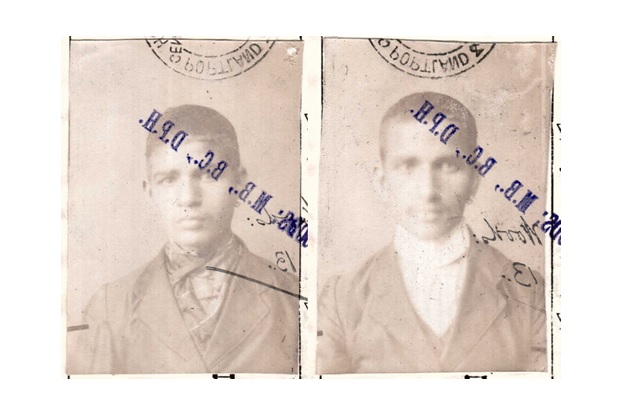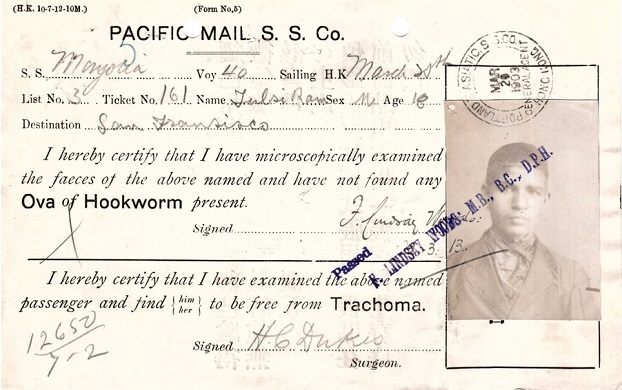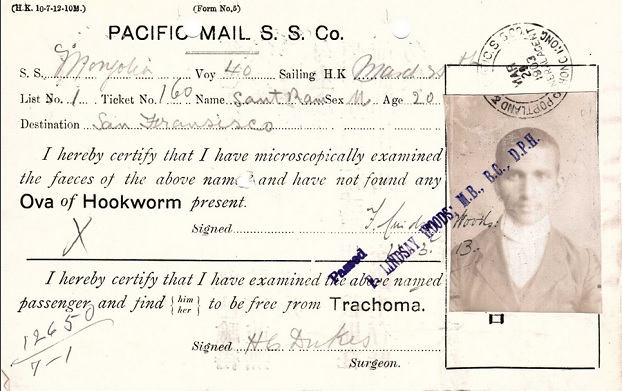
The following piece is part of The Aerogram’s collaboration with the South Asian American Digital Archive (SAADA), which documents and shares the history of South Asian Americans.
***
On April 22, 1913, the SS Mongolia steamed into San Francisco with two Indian brothers aboard: Sant and Tulsi Ram. They had big dreams. Older brother Sant, age 20, planned to study mechanical engineering, and younger brother Tulsi, age 18, sought to pursue studies in agriculture.
After arriving, the brothers were detained at San Francisco Bay’s Angel Island Immigration Station, where the two were questioned about their plans for living in the United States and their ability to financially support themselves, according to immigration documents available through the South Asian American Digital Archive.
Tulsi said he came to America to “prosecute my studies,” according to a transcript of an interview he had with immigration authorities. He said he planned to study in Pittsburgh, Pennsylvania, and when asked why Pittsburgh of all places, he replied, with a bit of awkward English: “I heard from my teacher, the headmaster of the school I was in, that Pittsburgh was a good school for me to learn.”
When questioned about how he’d financially support himself in America, Tulsi said his father, a “merchant of oil cakes,” would provide for him, and when asked whether his father was “a man of wealth,” Tulsi succinctly replied, “Yes, sir.”
The barely adult Tulsi seems to have sailed through his immigration processing smoothly, because the end of the transcript reads, “It is the unanimous opinion of the Board that this alien be admitted.”

If only it had been so relatively easy for older brother Sant.
When questioned, Sant presented identity documents issued by Arya High School in Ludhiana, in present-day Punjab, India. When asked if he had been examined for disease prior to embarking for San Francisco, he answered “Yes, sir.” And Sant’s immigration documents do include a certificate dated prior to his arrival in which a medical authority signed his signature attesting, “I hereby certify that I have microscopically examined the faeces of the above named and have not found any Ova of Hookworm present.”

Unfortunately, another medical certificate, dated April 23, 1913, the day after the brothers’ arrival, says Sant had been found to be afflicted with “UNCINARIASIS:- infection of the intestinal tract with hookworm. A DANGEROUS, CONTAGIOUS DISEASE.” It appears that at some point between the two certificates, Sant got infected. The immigration authorities told him that he would be deported unless he received treatment and was cured.
Sant’s situation wasn’t uncommon for South Asian immigrants at the time: Hookworm was found in 65 percent of South Asians coming through Angel Island, according to a source cited in the article “Infecting Angel Island,” from SAADA’s Tides magazine. (As recently as the early 2000s, hookworm infection rates were as high as 29.9 percent in some regions of India.) At Angel Island, those infected had to pay for treatment; otherwise they were deported.
Hookworm infection is of course a public health concern, but the aversion to hookworm also played into the narrative that Asian immigrants posed threats. Infected people were said to have low work productivity, and a 1911 report by the Rockefeller Sanitary Commission for the Eradication of Hookworm Disease stated: “Every group of Indian coolies now in California is a center from which the infection is spreading in that State.” Thus hookworm was a common reason for keeping out South Asians.
It is in fact the case that hookworm can cause humans to feel weak and tired, though it rarely kills them. It’s usually acquired by walking barefoot in warm, moist areas with poor sanitation. In the early 1900s, up to 40 percent of people in some areas of the rural American South were infected, possibly contributing to the stereotype of the lazy, slow Southerner (and probably especially so if the Southerner was African American).
“Hookworms and the Myth of the ‘Lazy Southerner,'” an episode of Gross Science, a YouTube series from NOVA and PBS Digital Studios.
The good news is that hookworm is treatable, and that seems to have been the case with Sant. He was billed $18.75 (about $465 in today’s dollars) for hospital care, and it appears he was free to go after that.
Did the Ram brothers make it to Pittsburgh? That’s unknown. A payroll document from the Southern Pacific Company lists a Tulsi Ram working for the railroads in 1916. A 1930 census report includes a Tulsi Ram employed at a sawmill in Grays Harbor, Washington. The rest of the brothers’ story seems to be lost to history, but they have their own little place in the story of South Asian immigration to the United States.
***
Preeti Aroon (@pjaroonfp) is a Washington, D.C.–based copy editor at National Geographic and was formerly copy chief at Foreign Policy.












